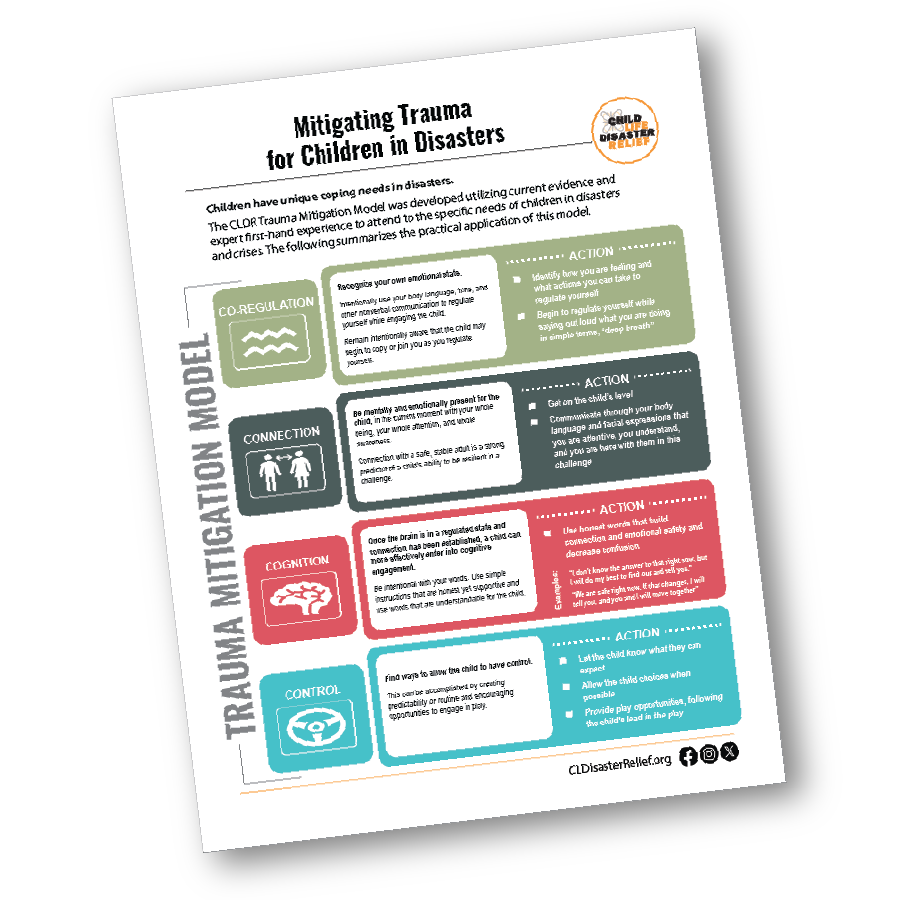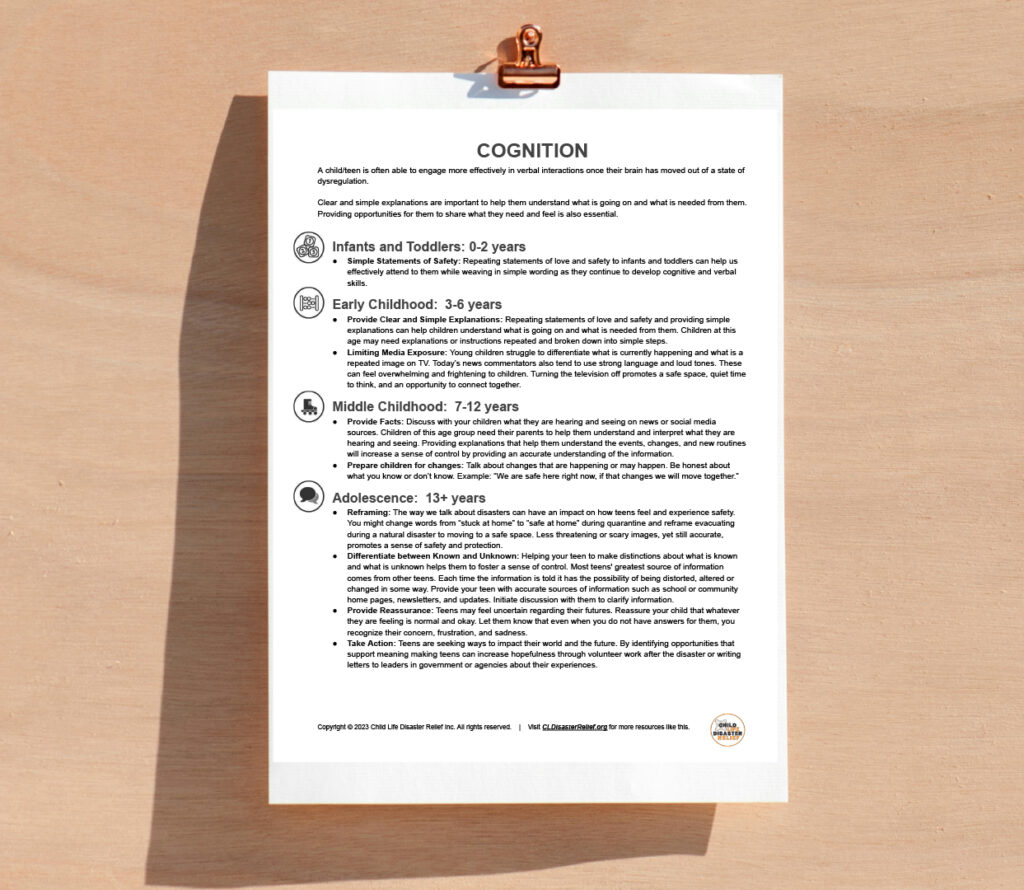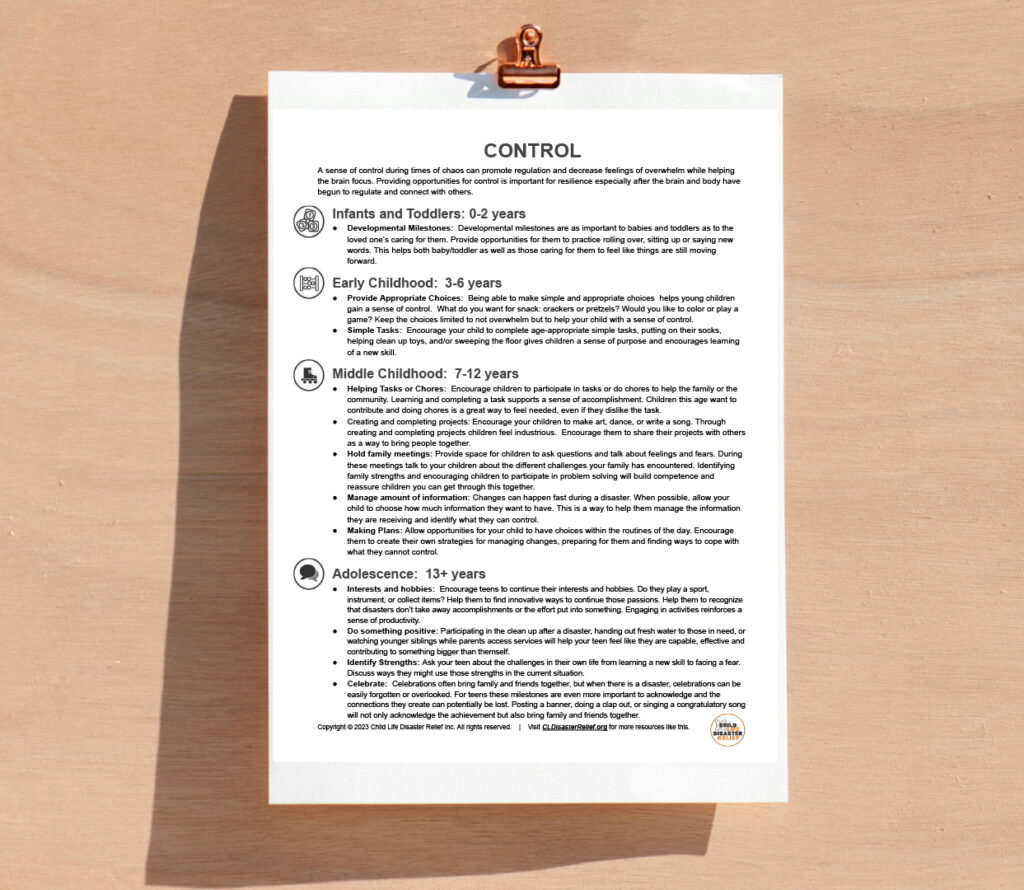Trauma Mitigation Model
When the world feels chaotic and out of control, help children and teenagers to build resilience by applying the four C’s of the CLDR Trauma Mitigation Model. The following videos and tips sheets are a guide for families and caregivers wanting to support children and teenagers after a disaster.

One-Page Trauma Mitigation Handout
Download our one-page handout all about mitigating trauma for children in disasters.
CO-REGULATION
In times of stress or high anxiety the body and the brain may feel overwhelmed or scattered. Helping children regulate begins with our own intentional regulation followed closely by COREGULATING with children.
Regulating ourselves through awareness of our emotions and our surroundings, deep breathing, and rhythmic movements increases our ability to effectively help children and teenagers regulate WITH us and move from chaos to control.
Resources
- Rhythmic movement: Holding and rocking your baby back and forth or using a baby swing or bouncer to create a consistent motion helps to regulate the heartbeat, body temperature and movement.
- Songs: Singing a lullaby or playful song to your baby can help calm them when upset or just have some fun when under stress. Singing with your baby also supports the connection between baby and loved one.
- Gentle stroking and massage: Infants have a sense of the emotional state of their caregivers and will benefit from slow rhythmic touch; stroking across a baby’s forehead, gently stroking of hands and feet helps to regulate a baby’s heartbeat, body temperature and movement.
- Change of Scenery: Put your baby in a stroller or your toddler in a wagon and move around. You don’t have to go far or anywhere at all. The change in position, placement, room or environment is often enough for you and your baby or toddler to reset and regulate.
CLDR’s Genevieve Lowry talks about a brething exercise helpful in early childhood.
- Breathe: Encourage your young child to practice deep breaths. You can do this using pinwheels, party blowers, or bubbles. Breathing helps your child calm down and regulate their own body.
- Empathic Responses: Name your child’s feelings. This will help to develop the language they need to name their feelings, giving them the tools to regulate their own emotions.
- Ride the Emotional Wave: When big feelings occur, you may need to hold, love, and support your child as they cry or tantrum it out of their body. Try to resist the urge to tell your child it will be okay. Being quiet or gently humming, your child will feel supported while gaining control of their own body and feelings.
- Create a Safe Space: Create a safe space where children can go to express emotions freely. Provide pillows for punching or yelling into, art and writing materials for drawing or writing about feelings, as well as space for music and movement.
- Validate children’s feelings don’t try to change them: By validating children’s feelings you are acknowledging their experience. Let children be upset before moving towards “fixing” the problem. This will help you child learn to regulate their own emotions.
- State your Availability to them: Recognize they may move back and forth from a need to have you close to a need to have alone-time. Let them know you are available and respectful of either need.
CLDR’s Genevieve Lowry talks about what might be helpful an adolescent with regulation.
- Guidance: Say encouraging, short phrases to them when they are feeling dysregulation. Example: “breathe with me”, “you are safe right now”, “I am here with you”, “we will get through this together”. Gently guiding your teen out of a dysregulated loop and begin to manage negative and stress inducing emotions.
- Grounding: When upset grounding helps the body/brain regulate itself back to baseline, by focusing on the sensations of leaning against a wall, reciting a poem, or taking a short walk.
- Music and Movement: Getting the body up and moving helps to release tension anxiety and stress we might be holding or storing. Listening to music uses a different part of the brain and can help override negative thoughts and feelings.
CONNECTION
In times of stress and chaos, connection with others is the most essential component for developing resilience.
Resources
CLDR’s Genevieve Lowry talks about what might be helpful to an Infant/Toddler with Connection.
- Be present: Be present with your baby or toddler by providing moments of your undivided attention. Look into your baby’s eyes while nursing or giving a bottle, repeat the sounds and gurgles your baby makes, and narrate your baby’s movements or play. These simple moments of attention can help you and your baby feel connected to one another and ease each other’s stress and anxiety.
- Snuggle Time: Preschoolers may regress to earlier stages of development or cling to you or a security item. Build into the routine snuggle times, read a book, play, or engage in nature, art or music together. Even if only for a few minutes, these snuggle breaks will increase your connection with your child.
- Play: Even if you only take a few minutes, take time to fully engage with your child in something they like to do. Read a story or engage in play. Play helps children feel seen and heard. Play provides an important opportunity to share connection to each other especially within stress.
- Family activity: Engage your young children in family activities such as reading a story or singing a song together. Connection is important through positive or fun interactions and it is also important through hard or sad moments. Connecting in the genuine emotions decreases feelings of aloneness within struggles and challenges.
- Hugs not Shrugs: As children get closer to adolescence, (think tweens) they may not want to be hugged as much. However, often during times of stress, children need both physical and emotional expressions of a parent’s presence. Text messages, email, and sticky notes can be simple ways to let your child know you are there.
- Provide Quiet Presence: Sitting quietly with your child especially in times of heightened stress or emotion can often communicate more than words. Connecting non-verbally in genuine emotions decreases feelings of aloneness within struggles and challenges.
- Play: Even if you only take a few minutes, take time to fully engage with your child in something they like to do. Connecting in this way helps children feel seen and heard. Play provides an important opportunity to share connection to each other especially within stress.
- Family activity: Engage your children in family activities such as reading a story or singing a song together. Connection is important through positive or fun interactions and it is also important through hard or sad moments.
- Connect before Correcting: Teens may demonstrate angry behaviors as they work through their emotions. Correction is important, however connecting prior to correction can help build support in challenging times. For example, in response to an angry statement from a teen, you can say,, “I hear you. Things are really hard right now. Try saying that another way”
- Encourage Peer Support: Encourage opportunities to connect with peers, especially with peers experiencing similar challenges.
- Family activity: Engage your teen in family activities. Connection is important through positive or fun interactions and it is also important through hard or sad moments.
- Community/Spirituality/Faith: Meditation, prayer and community can provide us with a sense of connection. Encourage and/or listen to your teen’s ideas about who and what helps them feel connected and the practices that support that connection.
CONGNITION
A child/teen is often able to engage more effectively in verbal interactions once their brain has moved out of a state of dysregulation.
Clear and simple explanations are important to help them understand what is going on and what is needed from them. Providing opportunities for them to share what they need and feel is also essential.
Resources
- Simple Statements of Safety: Repeating statements of love and safety to infants and toddlers can help us effectively attend to them while weaving in simple wording as they continue to develop cognitive and verbal skills.
- Provide Clear and Simple Explanations: Repeating statements of love and safety and providing simple explanations can help children understand what is going on and what is needed from them. Children at this age may need explanations or instructions repeated and broken down into simple steps.
- Limiting Media Exposure: Young children struggle to differentiate what is currently happening and what is a repeated image on TV. Today’s news commentators also tend to use strong language and loud tones. These can feel overwhelming and frightening to children. Turning the television off promotes a safe space, quiet time to think, and an opportunity to connect together.
- Provide Facts: Discuss with your children what they are hearing and seeing on news or social media sources. Children of this age group need their parents to help them understand and interpret what they are hearing and seeing. Providing explanations that help them understand the events, changes, and new routines will increase a sense of control by providing an accurate understanding of the information.
- Prepare children for changes: Talk about changes that are happening or may happen. Be honest about what you know or don’t know. Example: “We are safe here right now, if that changes we will move together.”
- Reframing: The way we talk about disasters can have an impact on how teens feel and experience safety. You might change words from “stuck at home” to “safe at home” during quarantine and reframe evacuating during a natural disaster to moving to a safe space. Less threatening or scary images, yet still accurate, promotes a sense of safety and protection.
- Differentiate between Known and Unknown: Helping your teen to make distinctions about what is known and what is unknown helps them to foster a sense of control. Most teens’ greatest source of information comes from other teens. Each time the information is told it has the possibility of being distorted, altered or changed in some way. Provide your teen with accurate sources of information such as school or community home pages, newsletters, and updates. Initiate discussion with them to clarify information.
- Provide Reassurance: Teens may feel uncertain regarding their futures. Reassure your child that whatever they are feeling is normal and okay. Let them know that even when you do not have answers for them, you recognize their concern, frustration, and sadness.
- Take Action: Teens are seeking ways to impact their world and the future. By identifying opportunities that support meaning making teens can increase hopefulness through volunteer work after the disaster or writing letters to leaders in government or agencies about their experiences.
CONTROL
A sense of control during times of chaos can promote regulation and decrease feelings of overwhelm while helping the brain focus.
Providing opportunities for control is important for resilience especially after the brain and body have begun to regulate and connect with others.
Resources
- Developmental Milestones: Developmental milestones are as important to babies and toddlers as to the loved one’s caring for them. Provide opportunities for them to practice rolling over, sitting up or saying new words. This helps both baby/toddler as well as those caring for them to feel like things are still moving forward.
- Provide Appropriate Choices: Being able to make simple and appropriate choices helps young children gain a sense of control. What do you want for snack: crackers or pretzels? Would you like to color or play a game? Keep the choices limited to not overwhelm but to help your child with a sense of control.
- Simple Tasks: Encourage your child to complete age-appropriate simple tasks, putting on their socks, helping clean up toys, and/or sweeping the floor gives children a sense of purpose and encourages learning of a new skill.
- Helping Tasks or Chores: Encourage children to participate in tasks or do chores to help the family or the community. Learning and completing a task supports a sense of accomplishment. Children this age want to contribute and doing chores is a great way to feel needed, even if they dislike the task.
- Creating and completing projects: Encourage your children to make art, dance, or write a song. Through creating and completing projects children feel industrious. Encourage them to share their projects with others as a way to bring people together.
- Hold family meetings: Provide space for children to ask questions and talk about feelings and fears. During these meetings talk to your children about the different challenges your family has encountered. Identifying family strengths and encouraging children to participate in problem solving will build competence and reassure children you can get through this together.
- Manage amount of information: Changes can happen fast during a disaster. When possible, allow your child to choose how much information they want to have. This is a way to help them manage the information they are receiving and identify what they can control.
- Making Plans: Allow opportunities for your child to have choices within the routines of the day. Encourage them to create their own strategies for managing changes, preparing for them and finding ways to cope with what they cannot control.
- Interests and hobbies: Encourage teens to continue their interests and hobbies. Do they play a sport, instrument, or collect items? Help them to find innovative ways to continue those passions. Help them to recognize that disasters don’t take away accomplishments or the effort put into something. Engaging in activities reinforces a sense of productivity.
- Do something positive: Participating in the clean up after a disaster, handing out fresh water to those in need, or watching younger siblings while parents access services will help your teen feel like they are capable, effective and contributing to something bigger than themself.
- Identify Strengths: Ask your teen about the challenges in their own life from learning a new skill to facing a fear. Discuss ways they might use those strengths in the current situation.
- Celebrate: Celebrations often bring family and friends together, but when there is a disaster, celebrations can be easily forgotten or overlooked. For teens these milestones are even more important to acknowledge and the connections they create can potentially be lost. Posting a banner, doing a clap out, or singing a congratulatory song will not only acknowledge the achievement but also bring family and friends together.



